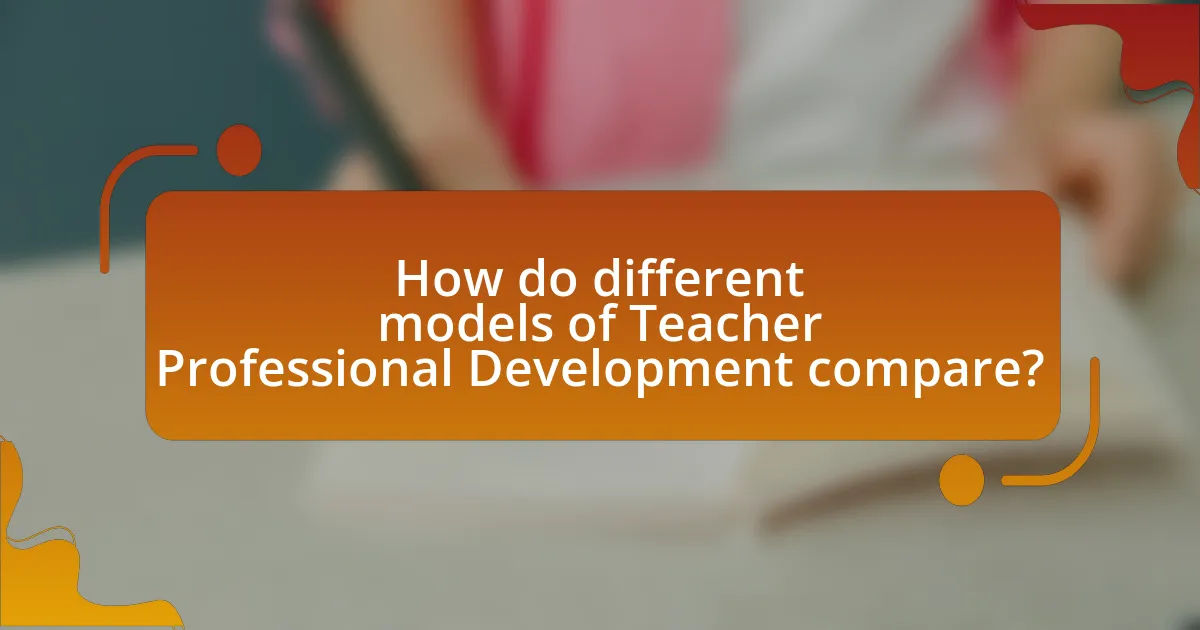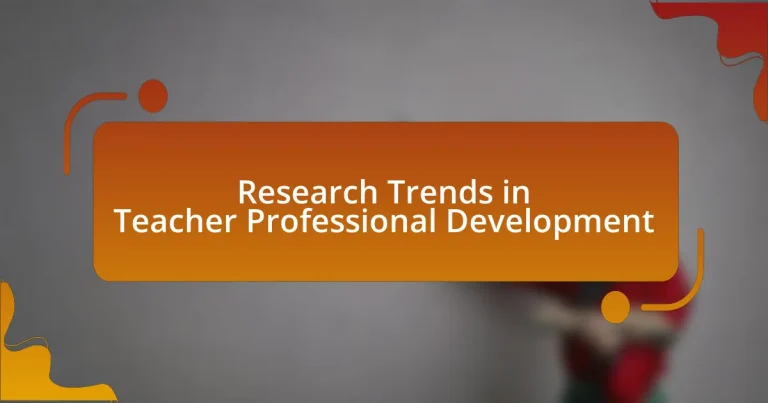The article focuses on current research trends in Teacher Professional Development (TPD), highlighting the shift towards personalized learning, collaborative practices, and technology integration. It examines how these trends have evolved over the past decade, influenced by advancements in technology and educational policy, and discusses various methodologies used in TPD research, including qualitative and quantitative approaches. Key themes emerging from recent studies emphasize the importance of collaboration and student-centered learning, while the article also addresses the challenges faced in implementing effective TPD and offers best practices for enhancing teacher growth. Overall, the article underscores the significant impact of effective professional development on teaching practices and student outcomes.

What are the current research trends in Teacher Professional Development?
Current research trends in Teacher Professional Development focus on personalized learning, collaborative practices, and the integration of technology. Personalized learning emphasizes tailoring professional development to meet individual teachers’ needs, enhancing engagement and effectiveness. Collaborative practices involve peer coaching and professional learning communities, which foster shared knowledge and support among educators. The integration of technology highlights the use of digital tools and online platforms to facilitate ongoing learning and access to resources. These trends are supported by studies indicating that targeted, collaborative, and technology-enhanced professional development leads to improved teaching practices and student outcomes. For instance, a study by Darling-Hammond et al. (2017) in “The Future of Teaching” found that effective professional development significantly impacts teacher effectiveness and student achievement.
How have these trends evolved over the past decade?
Research trends in teacher professional development have evolved significantly over the past decade, shifting towards more personalized and collaborative approaches. In the early 2010s, traditional, one-size-fits-all workshops dominated the landscape, but recent trends emphasize ongoing, job-embedded learning opportunities that cater to individual teacher needs. For instance, studies indicate that professional learning communities (PLCs) have gained traction, with 75% of teachers reporting participation in such collaborative groups by 2020, compared to only 30% in 2011. Additionally, the integration of technology in professional development has surged, with online platforms and resources becoming essential tools for educators, reflecting a broader trend towards blended learning environments. This evolution underscores a growing recognition of the importance of continuous, context-specific professional growth for teachers.
What factors have influenced the evolution of these trends?
The evolution of trends in teacher professional development has been influenced by several key factors, including advancements in technology, shifts in educational policy, and the growing emphasis on student-centered learning. Technological advancements, such as online learning platforms and digital resources, have transformed how teachers access professional development, making it more flexible and accessible. Educational policies, particularly those promoting accountability and standards-based education, have driven the need for ongoing teacher training to meet new requirements. Additionally, the focus on student-centered learning has encouraged professional development programs to prioritize collaborative and experiential learning approaches, aligning with contemporary pedagogical theories. These factors collectively shape the landscape of teacher professional development, ensuring it evolves to meet the changing needs of educators and students.
How do these trends reflect changes in educational policy?
Trends in teacher professional development reflect significant changes in educational policy by emphasizing evidence-based practices and continuous learning. For instance, the shift towards collaborative learning models and mentorship programs indicates a policy focus on improving teaching quality through peer support and shared expertise. Research shows that states implementing such policies have seen improved student outcomes, as highlighted in the 2020 report by the National Center for Teacher Quality, which found that schools with structured professional development frameworks reported higher teacher retention rates and enhanced student performance. This alignment of professional development with educational policy underscores a commitment to fostering a more effective teaching workforce.
What methodologies are commonly used in researching Teacher Professional Development?
Common methodologies used in researching Teacher Professional Development include qualitative methods, quantitative methods, and mixed-methods approaches. Qualitative methods often involve case studies, interviews, and focus groups to gather in-depth insights into teachers’ experiences and perceptions. Quantitative methods typically utilize surveys and experimental designs to measure the effectiveness of professional development programs through statistical analysis. Mixed-methods approaches combine both qualitative and quantitative techniques, allowing for a comprehensive understanding of the impact of professional development on teaching practices. Research by Desimone (2009) highlights that these methodologies are essential for evaluating the effectiveness and relevance of professional development initiatives in enhancing teacher skills and student outcomes.
What qualitative methods are prevalent in this research area?
In the research area of Teacher Professional Development, prevalent qualitative methods include interviews, focus groups, and case studies. Interviews allow for in-depth exploration of teachers’ experiences and perceptions, while focus groups facilitate discussion among educators, revealing collective insights. Case studies provide comprehensive examinations of specific professional development programs, illustrating their impact and effectiveness. These methods are widely recognized for their ability to capture nuanced data and foster a deeper understanding of the complexities involved in teacher development.
How do quantitative approaches contribute to understanding Teacher Professional Development?
Quantitative approaches contribute to understanding Teacher Professional Development by providing measurable data that can identify trends, effectiveness, and areas for improvement. These approaches utilize statistical methods to analyze large datasets, enabling researchers to assess the impact of professional development programs on teacher performance and student outcomes. For instance, studies have shown that quantitative analyses can reveal correlations between specific training interventions and improvements in teaching practices, as evidenced by research conducted by Garet et al. (2001) in “What Makes Professional Development Effective? Results from a Study of the Effect of Professional Development on Teachers’ Instruction.” This research highlights that structured, content-focused professional development leads to significant changes in classroom practices, demonstrating the value of quantitative data in evaluating and enhancing teacher training initiatives.
What are the key themes emerging from recent studies?
Recent studies in teacher professional development highlight key themes such as the importance of collaborative learning, the integration of technology, and the focus on student-centered approaches. Collaborative learning fosters a community of practice among educators, enhancing their skills through shared experiences and peer feedback. The integration of technology is increasingly emphasized, with studies showing that digital tools can facilitate personalized learning and improve instructional strategies. Additionally, a shift towards student-centered approaches is evident, where professional development programs prioritize the needs and engagement of students, leading to more effective teaching practices. These themes are supported by research findings that indicate improved teacher efficacy and student outcomes when these elements are incorporated into professional development initiatives.
How does technology integration play a role in Teacher Professional Development?
Technology integration significantly enhances Teacher Professional Development by providing educators with access to diverse resources, collaborative tools, and innovative teaching strategies. This integration allows teachers to engage in continuous learning through online courses, webinars, and virtual communities, which are essential for adapting to evolving educational demands. Research indicates that teachers who utilize technology in their professional development report increased confidence and improved instructional practices, as evidenced by a study published in the “Journal of Educational Technology & Society,” which found that 85% of teachers felt more effective in their roles after participating in technology-enhanced training programs. Thus, technology integration is crucial for fostering a culture of ongoing professional growth among educators.
What impact does collaborative learning have on teacher effectiveness?
Collaborative learning significantly enhances teacher effectiveness by fostering professional growth and improving instructional practices. When teachers engage in collaborative learning, they share strategies, resources, and feedback, which leads to a deeper understanding of pedagogical approaches. Research indicates that teachers who participate in collaborative professional development report increased confidence and competence in their teaching methods. For instance, a study by Vescio, Ross, and Adams (2008) found that collaborative learning environments positively influenced teachers’ instructional practices and student outcomes, demonstrating that collaboration leads to improved teaching effectiveness.

How do different models of Teacher Professional Development compare?
Different models of Teacher Professional Development (TPD) vary significantly in their approaches, effectiveness, and outcomes. For instance, traditional models often focus on one-time workshops that provide limited engagement and follow-up, while more contemporary models emphasize ongoing collaboration, coaching, and reflective practice. Research indicates that models incorporating sustained support and peer collaboration, such as Professional Learning Communities (PLCs), lead to higher teacher efficacy and improved student outcomes. A study by Vescio, Ross, and Adams (2008) found that teachers in PLCs reported greater changes in instructional practices compared to those participating in traditional workshops. Thus, the comparison reveals that models prioritizing continuous professional growth and collaborative learning tend to be more effective in enhancing teaching quality.
What are the most recognized models in Teacher Professional Development?
The most recognized models in Teacher Professional Development include the Standards-Based Model, the Collaborative Model, and the Reflective Model. The Standards-Based Model emphasizes aligning professional development with educational standards and student outcomes, ensuring that teachers acquire skills that directly impact student learning. The Collaborative Model focuses on peer interactions and teamwork, fostering a community of practice where teachers learn from one another. The Reflective Model encourages teachers to critically analyze their teaching practices and experiences, promoting continuous improvement through self-reflection. These models are widely acknowledged in educational research for their effectiveness in enhancing teacher skills and student achievement.
How does the coaching model differ from traditional workshops?
The coaching model differs from traditional workshops primarily in its personalized approach to professional development. In coaching, educators receive tailored support and feedback that focuses on their specific needs and goals, fostering a continuous learning environment. In contrast, traditional workshops often deliver standardized content to a group, limiting individual engagement and follow-up. Research indicates that personalized coaching can lead to a 10-20% increase in teacher effectiveness, as it allows for real-time application and reflection on teaching practices, which is less prevalent in the one-size-fits-all format of workshops.
What are the strengths and weaknesses of online professional development?
Online professional development offers flexibility and accessibility as its primary strengths, allowing educators to engage in learning at their own pace and from various locations. This format caters to diverse learning styles and schedules, enabling participation from teachers who may otherwise face barriers to traditional in-person training. A study by the Bill & Melinda Gates Foundation found that 90% of teachers prefer online learning for its convenience and ability to fit into their busy lives.
However, the weaknesses of online professional development include a lack of personal interaction and potential feelings of isolation among participants. The absence of face-to-face engagement can hinder networking opportunities and diminish the collaborative learning experience. Research published in the Journal of Educational Technology & Society highlights that online courses often struggle to maintain participant motivation and engagement, leading to lower completion rates compared to in-person programs.
How do these models address the diverse needs of teachers?
These models address the diverse needs of teachers by providing tailored professional development that considers individual teaching contexts, learning styles, and subject-specific requirements. For instance, differentiated professional development models allow teachers to engage in personalized learning experiences, which have been shown to enhance teaching effectiveness and student outcomes. Research indicates that when professional development is aligned with teachers’ specific needs and classroom realities, such as the study by Desimone (2009) in “Improving Impact Studies of Teachers’ Professional Development,” it leads to greater teacher satisfaction and improved instructional practices.
What strategies are effective for meeting the needs of novice teachers?
Effective strategies for meeting the needs of novice teachers include mentorship programs, targeted professional development, and collaborative learning communities. Mentorship programs pair novice teachers with experienced educators, providing guidance and support that enhances teaching practices and boosts confidence. Targeted professional development focuses on specific skills and knowledge areas relevant to novice teachers, ensuring that training is applicable and beneficial. Collaborative learning communities foster peer support and shared resources, allowing novice teachers to learn from one another and develop a sense of belonging within the school environment. Research indicates that these strategies significantly improve retention rates and teaching effectiveness among novice educators, as evidenced by studies showing that mentorship can reduce turnover by up to 50% and that collaborative practices enhance instructional quality.
How can professional development be tailored for experienced educators?
Professional development for experienced educators can be tailored by focusing on advanced pedagogical strategies, leadership opportunities, and personalized learning experiences. Experienced educators often benefit from collaborative learning environments where they can share best practices and engage in peer mentoring. Research indicates that professional development that is job-embedded and relevant to their specific teaching context leads to greater effectiveness; for instance, a study by Desimone (2009) highlights that sustained, collaborative professional development significantly enhances teacher practice and student outcomes. Additionally, offering options for self-directed learning allows experienced educators to pursue areas of interest, fostering a sense of ownership and relevance in their professional growth.

What are the outcomes of effective Teacher Professional Development?
Effective Teacher Professional Development leads to improved teaching practices, enhanced student learning outcomes, and increased teacher retention. Research indicates that when teachers engage in high-quality professional development, they are more likely to implement new strategies in the classroom, which can result in higher student achievement. For instance, a study by the National Staff Development Council found that effective professional development can increase student performance by up to 21 percentile points. Additionally, ongoing support and collaboration among educators during professional development contribute to a more positive school culture and greater job satisfaction, ultimately reducing turnover rates among teachers.
How does Teacher Professional Development impact student learning?
Teacher Professional Development significantly enhances student learning by equipping educators with updated pedagogical skills and knowledge. Research indicates that when teachers engage in high-quality professional development, student achievement improves, as evidenced by a study conducted by the National Staff Development Council, which found that effective professional development can lead to a 21 percentile point increase in student performance. Furthermore, ongoing training helps teachers implement innovative teaching strategies, adapt to diverse learning needs, and foster a more engaging classroom environment, all of which contribute to better educational outcomes for students.
What evidence supports the link between teacher training and student achievement?
Research indicates a strong link between teacher training and student achievement, with studies showing that effective professional development can lead to improved student outcomes. For instance, a meta-analysis by Yoon et al. (2007) found that professional development focused on content knowledge and pedagogical skills resulted in an average student achievement gain of 21 percentile points. Additionally, the National Center for Education Statistics reported that teachers who participated in high-quality training programs were more likely to implement effective teaching strategies, which directly correlated with higher student performance on standardized assessments. These findings underscore the importance of targeted teacher training in enhancing educational effectiveness and student success.
How do teacher attitudes and practices change as a result of professional development?
Teacher attitudes and practices change positively as a result of professional development. Research indicates that targeted professional development enhances teachers’ confidence, instructional strategies, and engagement with students. For instance, a study by Desimone (2009) highlights that effective professional development leads to improved teaching practices, as teachers adopt new methodologies and integrate them into their classrooms. Additionally, a meta-analysis by Yoon et al. (2007) found that professional development significantly impacts student achievement, demonstrating that when teachers feel supported and equipped with new skills, their attitudes towards teaching and learning also improve.
What are the challenges faced in implementing effective Teacher Professional Development?
The challenges faced in implementing effective Teacher Professional Development include insufficient funding, lack of time, and inadequate support from administration. Insufficient funding limits the resources available for high-quality training programs, which can hinder the development of teachers’ skills. Lack of time is a significant barrier, as teachers often have heavy workloads and limited opportunities to engage in professional development activities. Additionally, inadequate support from administration can lead to a lack of alignment between professional development initiatives and teachers’ actual needs, resulting in ineffective training. These challenges are documented in various studies, including the “State of Teacher Professional Development” report by the Learning Policy Institute, which highlights the importance of addressing these barriers to enhance the effectiveness of professional development programs.
What barriers do schools encounter when providing professional development?
Schools encounter several barriers when providing professional development, including limited funding, time constraints, and lack of administrative support. Limited funding restricts the ability to hire qualified trainers or purchase necessary resources, which directly impacts the quality of professional development offered. Time constraints arise from the demands of the school schedule, making it difficult for teachers to participate in training without disrupting their teaching responsibilities. Additionally, a lack of administrative support can lead to insufficient prioritization of professional development initiatives, resulting in low teacher engagement and ineffective training outcomes. These barriers collectively hinder the effectiveness and implementation of professional development programs in schools.
How can these challenges be overcome to enhance teacher growth?
To overcome challenges and enhance teacher growth, targeted professional development programs must be implemented that focus on collaboration, mentorship, and ongoing support. Research indicates that collaborative learning environments, where teachers share best practices and resources, significantly improve teaching effectiveness and student outcomes. For instance, a study by the National Center for Education Statistics found that teachers who participated in collaborative professional development reported higher levels of job satisfaction and effectiveness. Additionally, mentorship programs that pair experienced educators with novices can provide personalized guidance, fostering a culture of continuous improvement. By integrating these strategies, educational institutions can effectively address the challenges teachers face and promote their professional growth.
What best practices can be adopted for successful Teacher Professional Development?
Successful Teacher Professional Development can be achieved by adopting practices such as ongoing collaboration, needs assessment, and evidence-based strategies. Ongoing collaboration among educators fosters a supportive environment where teachers can share experiences and resources, enhancing their skills collectively. Conducting a needs assessment ensures that professional development is tailored to address specific gaps in knowledge and practice, making it more relevant and effective. Utilizing evidence-based strategies, such as coaching and mentoring, has been shown to improve teaching practices and student outcomes, as supported by research from the Institute of Education Sciences, which highlights that structured professional development leads to significant improvements in teacher effectiveness.
What role does ongoing support play in sustaining teacher development?
Ongoing support is crucial in sustaining teacher development as it provides continuous opportunities for growth, reflection, and adaptation to changing educational environments. This support can take various forms, including mentorship, professional learning communities, and access to resources, which collectively enhance teachers’ skills and confidence. Research indicates that teachers who receive ongoing support are more likely to implement new strategies effectively and remain engaged in their professional growth, leading to improved student outcomes. For instance, a study by the National Staff Development Council found that sustained professional development, characterized by ongoing support, significantly correlates with increased teacher effectiveness and student achievement.
How can feedback mechanisms improve professional development programs?
Feedback mechanisms can significantly enhance professional development programs by providing actionable insights that inform program design and delivery. These mechanisms, such as surveys, peer reviews, and performance assessments, allow educators to identify strengths and weaknesses in their practice. For instance, a study by the National Staff Development Council found that programs incorporating regular feedback led to a 30% increase in teacher effectiveness, as educators could adjust their strategies based on real-time input. This iterative process fosters a culture of continuous improvement, ensuring that professional development is responsive to the actual needs of educators.


